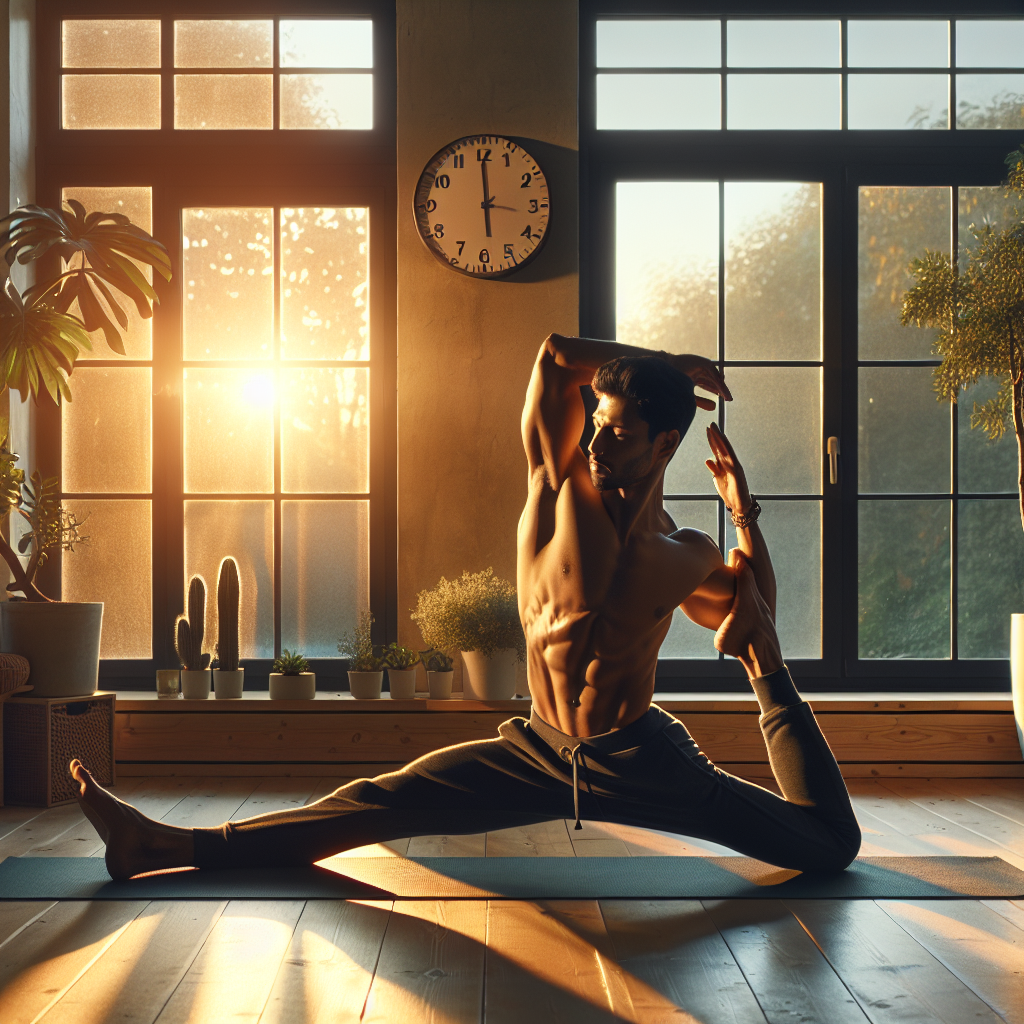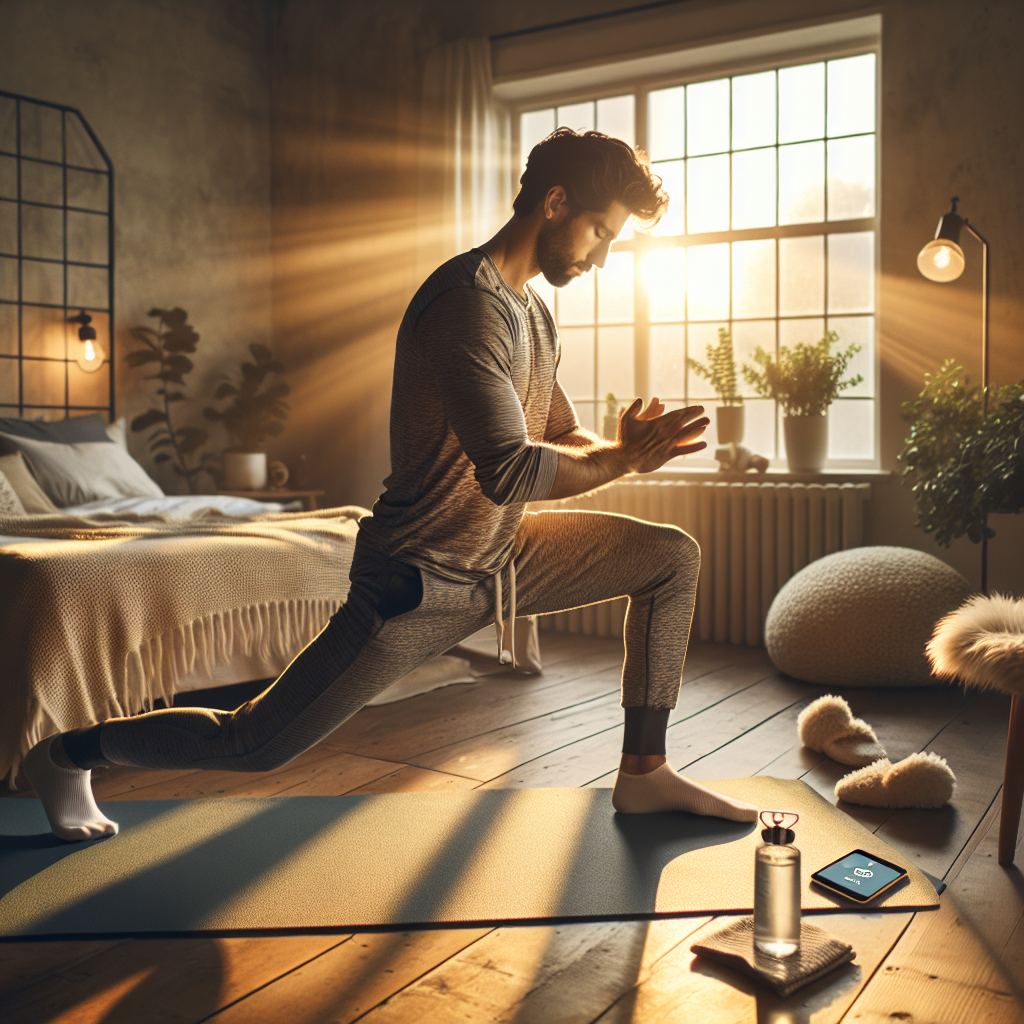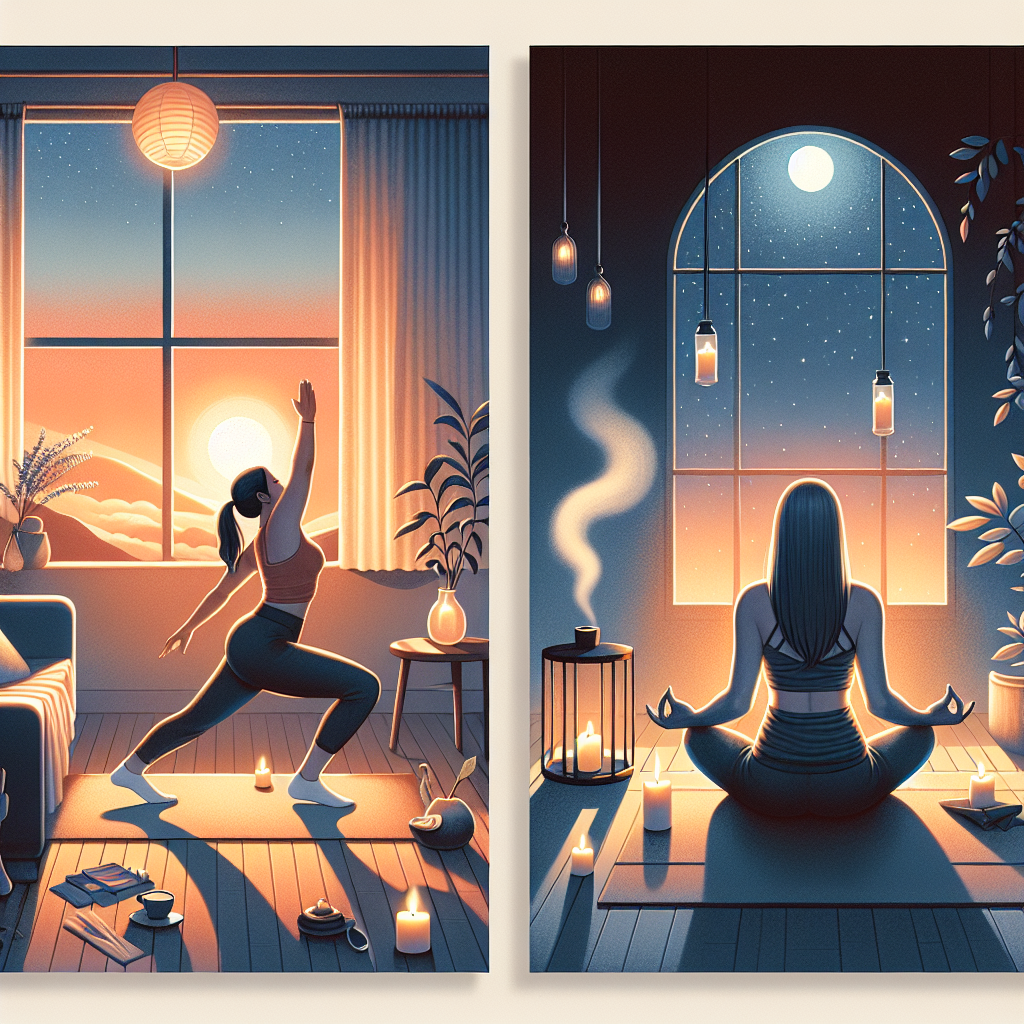Timing stretches correctly leads to better flexibility and improved results. Body temperature variations throughout the day create different conditions for stretching effectiveness.
Why Evening Stretching May Offer Better Flexibility
My research shows that evening stretches produce better flexibility gains because the body temperature typically peaks between 4-6 PM. During this time, muscles can stretch up to 20% more compared to early morning sessions. This means evening workouts can support deeper, safer flexibility gains.
Key Takeaways
- Evening stretching benefits from naturally warmer muscles and higher body temperature, making it ideal for deeper stretches.
- Morning stretches require extra warm-up time but help energize the body and improve posture for the day ahead.
- Your core body temperature peaks in the late afternoon, creating optimal conditions for flexibility work.
- Evening sessions can help reduce built-up daily tension and promote better sleep quality.
- Morning routines demand a gentler approach as muscles are naturally stiffer after sleep.
Choosing the Best Time for Your Routine
I recommend selecting a stretching time that fits your personal schedule while also considering your body’s natural rhythms. The most important factor is consistency. No matter the time of day, regularly performing stretches is what yields the most benefits over time.
Morning vs. Evening Stretches
- Morning stretches may need more preparation, but they help set a positive tone for the day.
- Evening stretches utilize the body’s warmth and help release any accumulated stress or tension from daily activities.
By understanding these differences, I can adapt my stretching routine to maximize its benefits regardless of the time I choose to stretch.
The Science Behind Morning vs. Evening Stretching
Morning stretching acts as a natural energizer, helping your body transition from sleep to wakefulness. By increasing blood flow to your muscles, morning stretches release stored tension and prime your body for the day ahead. This boost in circulation carries oxygen and nutrients throughout your body, helping you feel more alert and focused.
Evening stretches serve a different yet equally important purpose. As your body prepares for sleep, gentle stretching signals your nervous system to shift into a relaxed state. This calming effect helps reduce muscle tension built up during the day and can improve your sleep quality.
Understanding Temperature’s Role in Flexibility
Your body’s core temperature fluctuates throughout the day, which directly affects your stretching potential. In the morning, your body temperature is naturally lower, making your muscles and joints stiffer. That’s why I recommend starting with gentle movements and gradually increasing intensity through a proper stretching routine.
Evening stretching benefits from your naturally higher body temperature, as your muscles are typically more pliable. Here’s what makes each time unique:
- Morning stretches:
- Jump-start your metabolism
- Improve posture for the day ahead
- Enhance mental alertness
- Release muscle stiffness from sleep
- Evening stretches:
- Reduce accumulated daily tension
- Promote deeper sleep
- Help process physical stress
- Lower cortisol levels
The key isn’t choosing one time over the other – it’s understanding how to maximize the benefits of each. I suggest adapting your stretching intensity based on the time of day. Start slower in the morning when your body is cooler, and take advantage of your warmer muscles in the evening for deeper stretches.
Think of morning stretching as pressing the ‘start’ button on your body’s systems, while evening stretching is more like pressing ‘reset.’ Both serve distinct purposes in your daily wellness routine, and incorporating stretching at both times can create a balanced approach to flexibility and recovery.
Why Your Evening Stretch Session May Be Superior
The timing of your stretching routine plays a crucial role in its effectiveness and safety. I’ve found that evening stretching offers distinct advantages that can significantly boost your flexibility gains.
The Science Behind Evening Flexibility
Your body temperature naturally peaks between 4-6 PM, making this the prime time for stretching exercises. This elevated body temperature creates ideal conditions for your muscles and joints, leading to better results and reduced injury risk. In fact, research shows your range of motion can be up to 20% greater during evening hours compared to morning sessions.
Here’s what makes evening stretching particularly effective:
- Your muscles are naturally warmer and more pliable after a day of movement
- Core body temperature reaches its daily peak, enhancing flexibility
- Joint fluid has increased throughout the day, improving range of motion
- Muscle strength and power output are typically higher
- Risk of injury is lower due to warmed-up tissues
While morning stretching isn’t wrong, your body needs extra warm-up time to reach the same level of flexibility you’d naturally have in the evening. I always tell my clients that if they’re looking to make serious improvements in their flexibility, scheduling their stretching sessions for late afternoon or early evening can fast-track their progress.
The increased body temperature and enhanced range of motion during evening hours creates perfect conditions for pushing your flexibility limits safely. Think of it as working with your body’s natural rhythm rather than against it.

Making Morning Stretches Work For You
Getting Started With Morning Flexibility
I’ve found that morning stretching needs a gentler approach since your muscles are naturally colder and stiffer after sleep. Starting with dynamic stretches helps wake up your body safely before moving into deeper stretches. While your muscles take about 7-8 minutes longer to reach the same flexibility as evening stretching, the benefits are worth the extra time investment.
Benefits of Early Stretching Sessions
Starting your day with a proper stretching routine for flexibility sets you up for reduced muscle tension throughout your daily activities. I’ve discovered that morning stretches create a perfect foundation for building consistent habits – there are fewer disruptions or schedule conflicts compared to evening sessions.
Here’s what I recommend including in your morning stretch sequence:
- Arm circles and shoulder rolls to activate upper body
- Gentle trunk twists to warm up your core
- Hip circles and leg swings for lower body mobility
- Cat-cow stretches for spinal flexibility
- Walking in place to increase blood flow
The key is gradual progression – I start with smaller ranges of motion and slowly increase the stretch intensity as my body warms up. By following this approach, you’ll get the full benefits of morning stretching while protecting your muscles from potential strain. Remember to breathe deeply through each movement to help oxygenate your muscles and enhance your flexibility gains.
Your muscles might feel tighter first thing in the morning, but that’s completely normal. Give yourself those extra minutes to warm up properly, and you’ll create a sustainable stretching practice that energizes you for the day ahead.

How to Get Maximum Benefits From Night Stretching
I’ve found that nighttime stretching can be an incredible way to release built-up tension and prepare your body for restful sleep. Static stretches are particularly effective in the evening because your muscles are already warm from daily activities.
Essential Nighttime Stretching Tips
Creating a relaxing stretch routine before bed helps signal to your body that it’s time to wind down. Here are my key recommendations for an effective evening stretch session:
- Hold each stretch for 15-30 seconds without bouncing or forcing the movement
- Focus on the muscle groups you’ve used most during the day, like your back, shoulders, and legs
- Pay attention to your breathing – take slow, deep breaths to enhance relaxation
- Stretch in a quiet, comfortable space with minimal distractions
- Keep movements gentle and controlled to avoid overstimulating your body
I recommend including a mix of stretches that target different areas, starting from your neck and working down to your feet. A complete stretching routine helps ensure you don’t miss any major muscle groups.
Evening stretching can also help prevent nighttime muscle cramps, especially in your calves and feet. I’ve noticed that consistent nighttime stretching helps me fall asleep faster and wake up with less stiffness in the morning.
Remember to listen to your body and adjust the intensity of your stretches based on how you feel. If you’re particularly tight from a long day, spend extra time on those areas while maintaining gentle, controlled movements.
Customizing Your Stretch Routine Based on Goals
Performance and Recovery Focus
Athletic performance gets a significant boost from evening stretching sessions. Your muscles and joints are naturally warmer later in the day, making them more flexible and responsive to stretching. I’ve found that static stretching in the evening can help release tension built up from daily activities while improving recovery during sleep.
The timing of your stretches plays a crucial role in maximizing their benefits. Here are key factors to consider when planning your stretching routine based on specific goals:
- Performance enhancement: Schedule static stretches 2-3 hours before bedtime
- Muscle recovery: Focus on problem areas right before bed
- Stress relief: Gentle stretching 30-60 minutes before sleep
- Sleep quality: Light stretching combined with deep breathing at bedtime
Morning Energy and Prevention
Starting your day with dynamic stretches can spark natural energy production and prep your body for the day ahead. I recommend dynamic movements like leg swings, arm circles, and torso twists to gradually increase blood flow and muscle temperature.
Morning stretching shines for injury prevention, but it needs a slightly different approach than evening routines. Your muscles are naturally tighter in the morning, so I always start with lighter movements and gradually increase intensity. This helps prevent strain while still getting the full benefits of the stretch.
The beauty of stretching lies in its flexibility — you can adjust your routine to match your schedule and energy patterns. For optimal results, I suggest splitting your stretching between morning and evening sessions.
- Morning sessions: Focus on activation and injury prevention
- Evening routines: Target recovery and relaxation
Early birds might find they get more value from detailed morning routines, while night owls could benefit from longer evening sessions. Listen to your body’s natural rhythm and adjust accordingly. If you’re feeling particularly stiff in the morning, spend extra time warming up before starting your stretches. Similarly, if you’re dealing with muscle tension after a long day, dedicate more time to your evening routine.
What matters most is consistency rather than perfect timing. A regular stretching practice, regardless of time, will yield better results than sporadic sessions at the “perfect” hour. Pick a schedule that fits naturally into your daily routine and stick with it.

Stretching Safety Tips for Any Time of Day
Essential Safety Guidelines
I always emphasize being gentle with your body during stretching sessions – forcing or bouncing into positions can lead to injuries rather than improvements. The key is to ease into each stretch with controlled movements, holding positions steadily rather than making jerky motions. Sharp pain is your body’s warning signal to stop immediately – it’s different from the mild discomfort that comes with a good stretch.
Before starting any stretching routine, I make sure to drink plenty of water. Proper hydration helps keep muscles and connective tissues pliable, reducing the risk of strains or tears during stretching.
Preparing Your Body for Success
Starting with 5-10 minutes of light cardio is crucial for safe stretching. This could be:
- A brisk walk around the block
- Light jogging in place
- Arm circles and leg swings
- Dynamic marching
- Basic jumping jacks
I’ve learned that my body has natural flexibility patterns throughout the day. Some days I’m more flexible than others, and that’s perfectly normal. Rather than pushing against these patterns, I work with them. If I’m feeling particularly stiff, I’ll spend extra time warming up and be more conservative with my stretching depth.
Every person’s flexibility journey is unique – what works for someone else might not work for you. Pay attention to how your body responds to different stretches at various times. If morning stretches feel restricted, you might find better range of motion in the evening, or vice versa. The most important thing is maintaining consistency while respecting your body’s limits.

Sources:
Sleep Foundation – “Stretching Before Bed”
NCBI – “Stretch Timing Benefits”
Mayo Clinic – “Stretching Benefits”
Pingback: What Body Part Should I Stretch First?